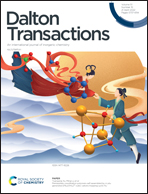A highly efficient Ti-catalyst for the deoxygenative reduction of esters under ambient conditions: experimental and mechanistic insights from DFT studies†
Abstract
In this paper, we report the synthesis of dianionic amidophosphineborane–supported titanium chloride [{Ph2P(BH3)N}2C6H4TiCl2] (1) and TiIV alkyl complex [{Ph2P(BH3)N}2C6H4Ti(CH2SiMe3)2] (2) using a salt metathesis reaction. TiIV complex 1 was obtained by the reaction of the bis-borane ligand [{Ph2P(BH3)NH}2C6H4] and TiCl4 in toluene followed by the addition of 2 equivalents of [LiN(SiMe3)2] at ambient temperature. TiIV bis-alkyl complex 2 was isolated from the reaction of complex 1 with 2.5 equivalents of LiCH2SiMe3 in toluene. The solid-state structure of complex 1 is established by single-crystal X-ray diffraction analysis. TiIV bis-alkyl complex 2 has proved to be a competent catalyst in the deoxygenative reduction of aliphatic and aromatic esters with pinacolborane (HBpin) to afford corresponding boryl ethers at room temperature under solvent-free conditions. Catalyst 2 exhibits chemoselectivity toward ester functionalities over halides, heteroatoms, olefins, and amino functional groups. DFT studies demonstrate that the active form of catalyst 2 is capable of easily transferring its hydrides to ester substrates at room temperature. The studies further reveal that the rate-limiting step (RLS) in an ester-to-boryl ether conversion is the cleavage of the C–O bond of an ester. In brief, the titanium-catalysed ester-to-boryl ether conversions are found to be downhill processes having small activation barriers along all mechanistic steps.



 Please wait while we load your content...
Please wait while we load your content...